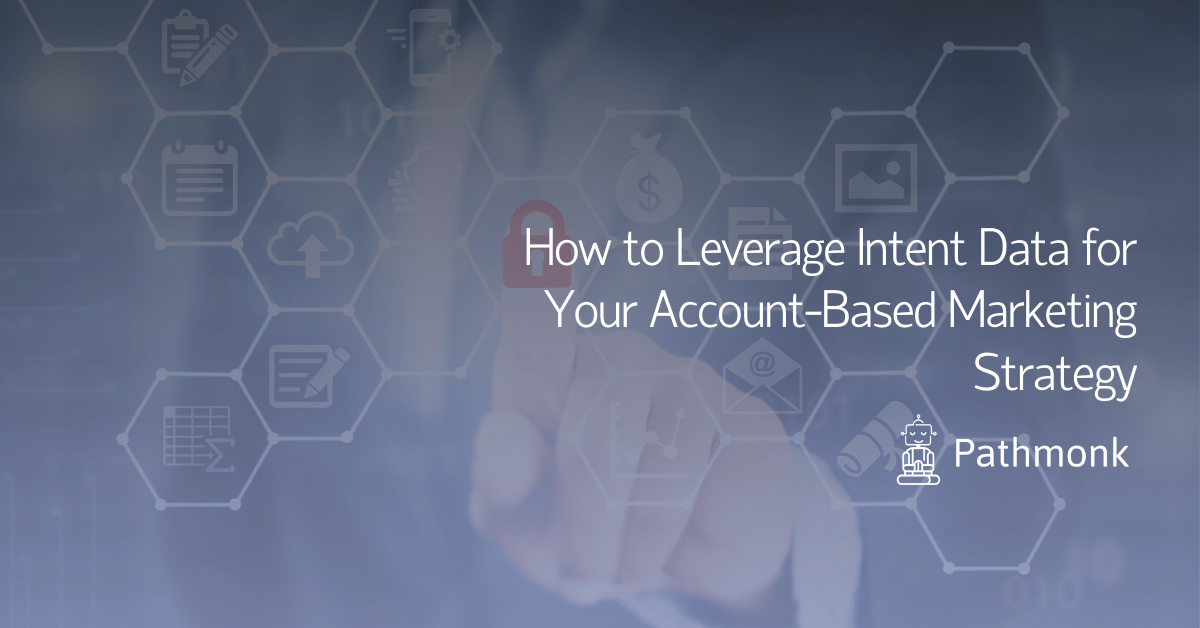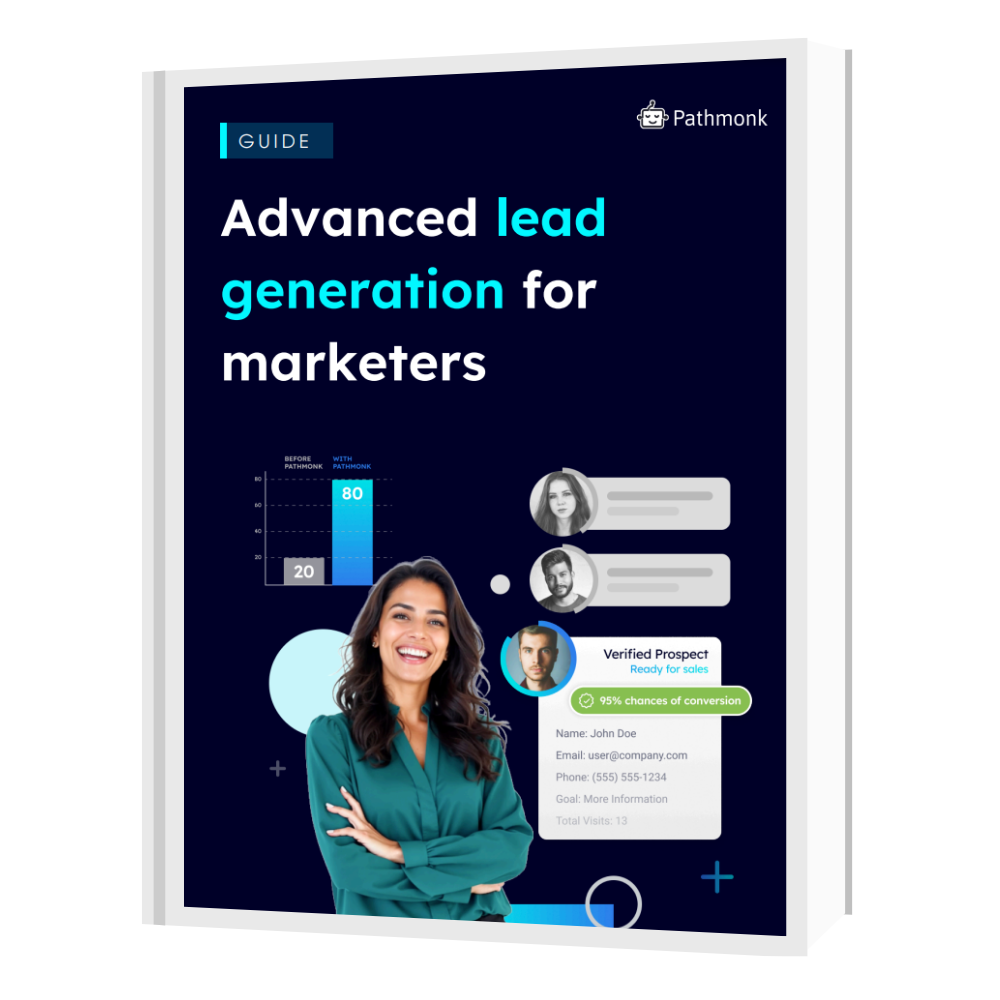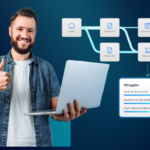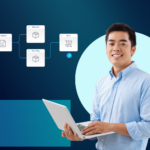
Account-based marketing (AMB) is an invaluable tool for B2B growth. Relationships are the key to success in this type of strategy, but they simply cannot work without information. Intent data is one of the most effective ways of gathering the intel needed to understand the direction your marketing should take; revolutionizing your entire B2B strategy.
Pathmonk’s marketing and lead conversion expertise are based on industry research and a deep understanding of what the customer sees and needs to see. By understanding the effect that intent data can have on your buying journey and eventual conversion rate, you can accelerate your B2B growth exponentially.
Generate better leads to grow your sales
Discover new strategies to unlocking a flood of high-quality leads from your website.

What Is Intent Data?
Unlike internal data that your company collects, which shows facts and figures based on actions taken, intent data investigates the unknown. Put in the simplest terms, this is the data collected from outside your digitally owned properties and tracks the activity from anonymous visitors that does not impact your numbers.
An example; when someone visits your website, looks through the available information, researches your product and pricing, then leaves without going any further. This type of data can show you how that person came to your site, what related searches they made, and what they are likely to do next.
All this information helps your marketing teams and is especially beneficial for ACM strategies. Check out this blog post for more information on how intent data can be used to generate leads.
It can be divided into three categories: first, second, and third party data. First and second-party data are made up of similar types of information. The difference is that first-party data comes from activity on your own site and second-party data is information from somebody else’s domain.
Third-party data comes from a much wider source and focuses more on aggregated data and behavior patterns. Pathmonk focuses on utilizing the data that is best suited to boost your business and generate leads.
What Type of Data Is Most Central in ABM Strategies?
With the purpose of B2B account-based marketing in mind, the most influential data is the first-party data you collect. What this refers to is any activity directly linked to your website. It can also be accumulated through any interactions with potential customers at any level.
Examples of how first-party data is collected are website cookies, social media monitoring tools, behavior flow tracking, and email interactions. The reason this is deemed to be centrally influential information is that it goes hand-in-hand with your buyer journey. Ultimately your targeted marketing is based on what users experience on your platform, not anywhere else.
Second and third-party data still has a part to play in ABM strategies but does not have the same impact in the end.
Read more about why first-party data is essential and influential in this Forbes Magazine article.
Why Is Data So Important to B2B Marketing?
InsightWhale’s Tony Simonovsky says that “data insights are the future of your business,” which is especially true for marketing strategies. Watch the full interview here.
Without data, everything is just a guess or a gut feeling. No matter how intuitive you may be or how well you know your industry, nothing can compare to cold hard statistics and facts. Pathmonk understands this and works to remove the need for making a gamble on how to run your B2B marketing and replace it with certainties of what people are truly looking for.
B2B selling is a tough market. The standard for conversion rates is generally low, but concise data insight can drastically improve statistics. To build relationships, you need to understand the mindset of the people you are marketing to, and intent data is a great way to open that door.
The business you are targeting is likely to have other companies competing for its attention. If one competitor approaches with a tailor-made, intent data-based marketing campaign and the other doesn’t, it could easily be the deciding factor.
What Is ABM?
Account-based marketing strategies revolve around personalized campaign designs aimed at specific accounts, clients, and markets. It is a way of targeting a selected potential buyer and marketing to them based on their personal interests and online behavioral flow.
This works by highlighting businesses or clients who are compatible with your product and launching an advertising and marketing campaign tailor-made to the key decision-makers based on collected data, complete with personalized messages.
Overview Of How ABM Works
- Use first-party intent data to determine the most valuable accounts
- Tie the accounts to individuals or businesses
- Layout a personalized campaign tailored to that individual or business
- Identify the best channels for communication and advertising
- Decide on the marketing roll-out process
- Launch the targeted campaign
- Monitor and measure the results
- Consider automated outreach if appropriate
- Evolve your strategy and campaign as it progresses if necessary
Why Pick This Strategy?
Industry experts say that account-based marketing should be the strategy of choice for B2B teams. This method lends itself perfectly to a B2B situation because of its personalized nature.
One of the most common pain points for B2B buyers and sellers is feeling unsupported by the opposite party, with lack of customer service being a common complaint. Starting off on the right foot with a personalized marketing campaign is an effective way of making your potential buyer feel valued. In turn, this makes them more likely to convert to a sale.
This strategy works particularly well in the B2B world because you have a strong data platform you can build on. With a little research, you can find a base for your campaign, then employ insights collected from first-party intent data to maximize the personalization.
A B2B relationship launched with a carefully considered, client-oriented marketing plan is instantly set up with an air of support, value, and communication. This is the ideal scenario to find yourself in at the beginning of any partnership or connection.
Some Effective Uses for Intent Data in an ABM Strategy
- Keyword and phrase selection: Learn more about what people search for and how to get your website noticed by more people. Using optimized terms could be the difference between a sale and no sale.
- Understanding and prioritizing leads: Knowing more about the intent of your visitors lets you prioritize what leads to follow. Visitors who only ever browse for general info are less likely to convert to a sale and are therefore not a priority.
- Those who carry far more urgency are the ones who look at products and show genuine interest in making a purchase. Capitalizing on these opportunities is the best way to get across the finish line and into a sale. Intent data allows you to tell the difference and figure out which is which.
- Targeted advertising: This is a popular method of getting the attention of a potential buyer. By tailoring adverts to a person’s unique needs and interests, you can peak an emotional investment and connection to your product.
- Knowing what content to provide: If you know what someone is searching for, you can speed up their process. Creating content matched to what a visitor requires makes the buyer’s journey smoother and more impactful. A powerful buyer’s journey is the road to improved conversion rates.
- Forecasting: Predicting what someone is most likely to need and when they are most likely to need it is one of the most advanced capabilities of well-utilized first-party intent data. You can set up an automated messaging program designed to pre-emptively reach out to potential buyers at the time determined to be optimal for a successful acquisition.
How Can Pathmonk Help?
Pathmonk offers quick and easy solutions for taking intent data and putting it into action. B2B teams need to know as much about the people visiting their website as possible in order to translate it into a streamlined and efficient ABM strategy.
Insight into what buyer personas are active on your website can show you the truth about your web traffic and how engaged your visitors actually are. It may sound complicated, but it is as simple as sending Pathmonk off on a deep dive and looking forward to actioning the results.
These services can help you create unique visitor journeys without making any changes to your website by improving your marketing strategy.
As Pathmonk’s many happy customer success stories prove, integrating this type of solution into your ABM strategy can lead to a dramatic conversion uplift and enhanced customer experience.
Final Thoughts
According to Forrester Research, B2B marketing teams have no choice but to revolutionize their current method of thinking and learn to optimize data leverage in their strategies. Data insight is essential for successful account-based marketing and should play a central part in your business’s future.
Separately, both first-party intent data and an ABM strategy are intelligent tools for growing and improving your B2B practices. Together, they are a formidable lead forward into modern-day best-practice business models and a sure-fire way to send your conversion rates through the roof.
Understand your customer journey analytics
See how your users behave, find drop-offs, and receive actionable insights with AI.









